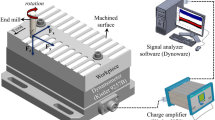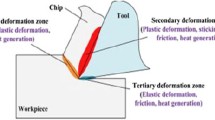Abstract
This paper investigates the cutting performance of a tungsten carbide end mill with hard coating and a sulfurous boric acid ester cutting fluid in milling A6061P-T651 aluminum alloy. The experiments were conducted to compare the milling force responses and flank wear under various cutting conditions. The results indicate that adding sulfurous boric acid ester cutting fluid decreases tool wear by 12.5% for hard coating tungsten carbide end mills and decreases the milling force by 10%. Besides, the average values of side and end flank wear of TiAlN-surface multilayer end mills can be decreased 38.7% and 68.7% respectively compared with uncoated and dry end mills.
Similar content being viewed by others
References
Baradie MAE (1996) Cutting fluids: part II- recycling and clean machining. J Mater Process Technol 56:798–806
Nedelik J, Lux B (1999) Improved tool performance by application of heat-spreading diamond layers within a multilayer coating? Int J Refract Met Hard Mater 17:275– 282
Chen CS (1998) High speed and high performance milling aluminum alloy in aerospace industry. Machinery Monthly 276:293–296 (in Chinese)
Machado AR, Wallbank J (1997) The effect of extremely low lubricant volumes in machining. Wear 210:76–82
Kelly JF, Cotterell MG (2002) Minimal lubrication machining of aluminum alloys. J Mater Process Technol 120:327–334
Varadarajan AS, Philip PK, Ramamoorthy B (2002) Investigations on hard turning with minimal cutting fluid application (HTMF) and its comparison with dry and wet turning. Int J Mach Tools Manuf 42(2):193–200
Cozzens, DA, Rao PD, Olson WW, Sutherland JW, Panetta JM (1999) An experimental investigation into the effect of cutting fluid conditions on the boring of aluminum alloys. ASME J Manuf Sci Eng 121(3):434–439
Kress D (1997) Dry cutting with finish machining tools. Ind Diamond Rev 57(574):81–85
Chia XM, Chang HL (1996) The effect of compound boric acid ester additives in water-based fluids. Mach Manuf 12:23–24 (in Chinese)
Mould RW, Silver HB, Syrett RJ (1977) Investigation of the activity of cutting oil additives part V - The EP activity of some water-based fluids. Lubr Eng 33(6):291–298
Jain VK, Shukla DS (1996) Study of the EP activity of water-soluble inorganic metallic salts for aqueous cutting fluids. Wear 193(1):226–234
Baradie MAE (1996) Cutting fluids: part I - characterization. J Mater Process Technol 56:786–797
Astakhov VP, Osman MOM (1996) Correlations amongst process parameters in metal cutting and their use for establishing the optimum cutting speed. J Mater Process Technol 62:175–179
Hung NP, Yeo SH, Oon BE (1997) Effect of cutting fluid on the machinability of metal matrix composites. J Mater Process Technol 67:157–161
Haan DM, Batzer SA, Olson WW, Sutherland JW (1997) An experimental study of cutting fluid effects in drilling. J Mater Process Technol 71:305–313
Mould RW, Silver HB, Syrett RJ (1972) Investigation of the activity of cutting oil additives part I- organo sulfur containing compounds. Wear 19(1):67–80
Mould RW, Silver HB, Syrett RJ (1972) Investigation of the activity of cutting oil additives part II- organo chlorine containing compounds. Wear 22(2):269–286
Shah MC (1958/59) On the action of metal cutting fluids at low speeds. Wear 2:217–227
Brown WL (1998) The role of polyalkylene glycols in synthetic metal working fluids. Lubr Eng 44(2):168–171
Tsao CC (2000) Study on tool life and surface roughness in milling aluminum alloys using sulfurous boric acid ester cutting fluids by Taguchi method. in: Proceedings of the 17th Conference CSME 4:425–428 (in Chinese)
Hedenqvist P, Olesson M, Wallen P, Kassman A, Hogmark S, Jacobson S (1990) How TiN coatings improve the performance of high speed steel cutting tools. Surf Coat Technol 41(2):243–256
Drozda TJ, Wick C (1983) Tool and manufacturing engineers handbook Vol. 1 - machining, 4th edn. SME, Dearborn, MI
Gunther KG, Freller H, Hintermann HE, Konig W (1989) Advanced coatings by vapour phase processes. Ann CIRP 38(2):645–655
Author information
Authors and Affiliations
Corresponding author
Rights and permissions
About this article
Cite this article
Tsao, C.C. An experiment study of hard coating and cutting fluid effect in milling aluminum alloy. Int J Adv Manuf Technol 32, 885–891 (2007). https://doi.org/10.1007/s00170-006-0417-6
Received:
Accepted:
Published:
Issue Date:
DOI: https://doi.org/10.1007/s00170-006-0417-6




